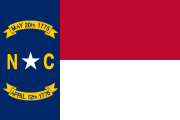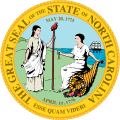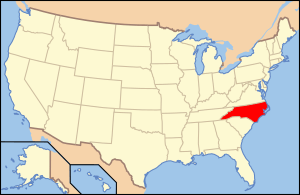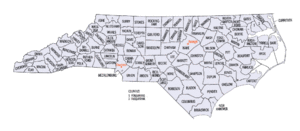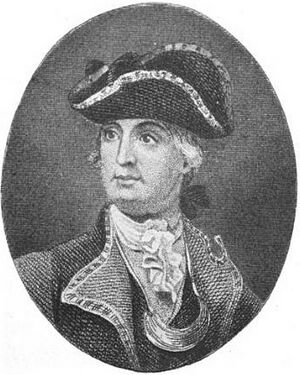Outline of North Carolina facts for kids
North Carolina is a state located on the Eastern Seaboard of the United States of America. It borders the North Atlantic Ocean and is part of the Southeastern United States.
North Carolina was one of the original Thirteen Colonies that helped form the United States. It played an important role in the nation's early history. The state signed the United States Declaration of Independence on July 4, 1776. Later, it was the 12th of the original 13 states to approve the Constitution of the United States of America on January 2, 1788.
During the American Civil War (1861-1865), North Carolina joined the Confederate States of America. After the war ended, it was welcomed back into the Union in 1868.
Contents
Exploring North Carolina
North Carolina is a U.S. state, which means it's a federal state of the United States. It is located in the Northern hemisphere and the Western hemisphere, specifically in North America. Within North America, it's part of the United States of America, found in the Eastern United States and the Southern United States.
As of the 2020 U.S. Census, the population of North Carolina was 10,439,388 people. You can learn more about the state's geography and features in the Atlas of North Carolina.
Special Places in North Carolina
North Carolina has many interesting places to visit and explore:
- Historic places: These include National Historic Landmarks and other sites listed on the National Register of Historic Places listings in North Carolina. Some bridges are also on this list.
- Natural landmarks: The state is home to National Natural Landmarks, which are special natural areas.
- Parks: You can find many National Park Service areas and state parks across North Carolina.
North Carolina's Environment
The state has a varied Climate of North Carolina. Its natural areas include:
- Protected lands: These are places like state forests that are set aside to protect nature.
- Wildlife: North Carolina is home to diverse wildlife, including many different birds.
- Coastal areas: The Tidewater region of North Carolina is a unique coastal area.
Natural Features of North Carolina
Regions of North Carolina
North Carolina is often divided into different regions, each with its own unique characteristics:
- Piedmont
- Eastern North Carolina
- Northeastern North Carolina
- Cape Fear
- Western North Carolina
- Piedmont Triad
How North Carolina is Divided
North Carolina is made up of 100 counties. Within these counties, there are:
- Municipalities: These are towns and cities.
- Cities: The state capital of North Carolina is Raleigh. Many cities have fun nicknames. Some cities also have "sister cities" in other countries, which are friendly partnerships.
- Unincorporated communities: These are smaller communities that are not officially part of a city or town.
- Townships: These are smaller divisions within counties.
People of North Carolina
You can learn more about the people living in North Carolina by looking at its demographics.
North Carolina's Military History
North Carolina has a rich military history, with various units serving the state and country.
Modern Military Units
- North Carolina Air National Guard
- North Carolina Army National Guard
Past Military Units
- Revolutionary War: During the American Revolution, North Carolina had its own militia units, the North Carolina Line, and North Carolina state troops in the American Revolution.
- Civil War: In the American Civil War, North Carolina had both Confederate and Union regiments.
History of North Carolina
The History of North Carolina is long and interesting, stretching back thousands of years.
Key Periods in North Carolina's History
- Early Times: Long before Europeans arrived, Indigenous peoples lived in North Carolina, including those of the Mississippian culture.
- Colonial Era:
- The Spanish explored the area, even building Fort San Juan in 1567.
- The English tried to set up the Colony of Roanoke in 1585, but it famously disappeared.
- The area became the Province of Carolina, first English, then British.
- The French and Indian War (1754–1763) also impacted the region.
- Revolutionary War Period:
- North Carolina played a big part in the fight for independence. Important meetings like the North Carolina Provincial Congress and resolutions like the Halifax Resolves (1776) showed the state's desire for freedom.
- The state was involved in the Cherokee–American wars.
- North Carolina was the tenth state to agree to the Articles of Confederation and Perpetual Union in 1778.
- The American Revolutionary War ended with the Treaty of Paris in 1783.
- After the Revolution:
- North Carolina was the twelfth state to approve the Constitution of the United States of America on November 21, 1789.
- The state was involved in the War of 1812.
- The Trail of Tears (1830–1838) saw many Native Americans forced from their lands.
- James K. Polk, from North Carolina, became the 11th President of the United States in 1845.
- Civil War Era:
- North Carolina joined the Confederate States of America on May 21, 1861, becoming the tenth state to do so.
- The state was heavily involved in the American Civil War.
- The Carolinas Campaign was a major military operation near the end of the war.
- After the Civil War:
- Andrew Johnson, also from North Carolina, became the 17th President of the United States in 1865.
- North Carolina went through a period called Reconstruction (1865–1868) and was readmitted to the United States in 1868.
History by Place
Many cities and counties in North Carolina have their own unique histories. For example, you can learn about the history of Asheville or the history of Charlotte. Each of North Carolina's 100 counties also has its own story, like the history of Alamance County.
History by Topic
Some specific historical topics in North Carolina include:
Culture of North Carolina
The Culture of North Carolina is rich and diverse.
- Museums: There are many museums to explore.
- Religion: Different faiths are practiced in North Carolina, such as The Church of Jesus Christ of Latter-day Saints and the Episcopal Church.
- Scouting: Scouting in North Carolina is popular.
- State Symbols: North Carolina has official State symbols of North Carolina, including its flag and Great Seal.
- Food: Barbecue in North Carolina is a very famous and delicious part of the state's culture!
Arts in North Carolina
- Music
- Theater
- Literature
Sports in North Carolina
Sports in North Carolina are a big part of life in the state. You can find many professional sports teams here.
Economy and Infrastructure of North Carolina
The Economy of North Carolina is strong and varied.
- Communication: This includes newspapers, radio stations, and television stations.
- Energy: North Carolina uses various sources for energy, including power stations, solar power, and wind power.
- Health Care: The state has many hospitals to care for its residents.
- Transportation: Getting around North Carolina is possible through its transportation networks, including airports, railroads, and the highway system.
Education in North Carolina
Education in North Carolina is important for the state's future.
- Schools: There are many school districts and high schools.
- Colleges and Universities: North Carolina has a wide range of colleges and universities, including the University of North Carolina System and the North Carolina Community College System.


